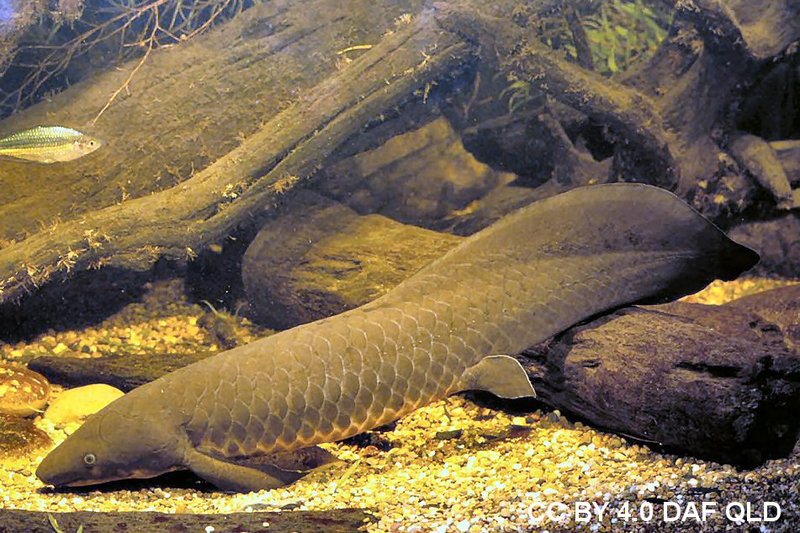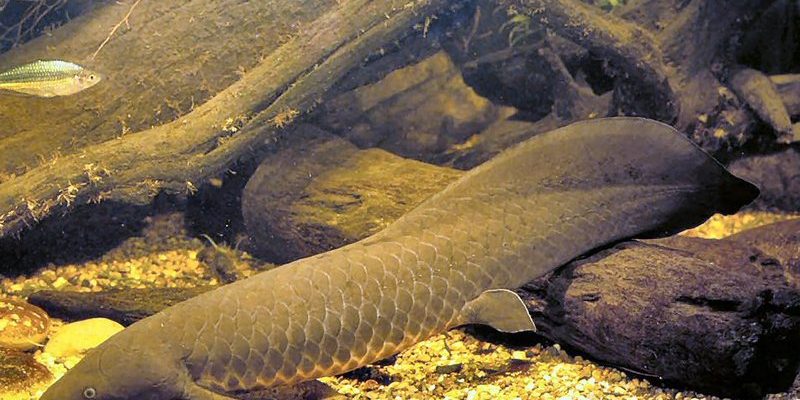
Have you ever heard of the Queensland Lungfish? This fascinating creature is like a living link to the past, representing an ancient lineage that dates back over 100 million years. Imagine a fish that can breathe air, swim gracefully in freshwater, and offers insights into the evolution of vertebrates—pretty amazing, right? Found in the serene waters of eastern Australia, the Queensland Lungfish is not just any fish; it’s a unique biological marvel that has adapted to its environment in remarkable ways.
But let’s dive deeper into what makes the Queensland Lungfish so intriguing. With its elongated body, large, paddle-like fins, and unique ability to breathe both through gills and lungs, this fish stands out in many ways. As we explore its habitat, diet, and physical characteristics, you’ll quickly understand why this species captivates so many nature enthusiasts and researchers alike.
Physical Characteristics
The Queensland Lungfish is often recognized for its distinctive features. Its body can grow up to 1.3 meters (or around 4.3 feet) in length, making it quite a sizeable fish. The skin is smooth and covered with a thin layer of mucus, which helps in respiration and protection. Interestingly, this fish has a streamlined shape, which allows it to glide through water with ease. The head is broad with large, round eyes that contribute to its keen vision.
One of the most remarkable aspects of the Queensland Lungfish is its unique fin structure. Unlike most fish that have sharp, pointed fins, this lungfish has large, fleshy, paddle-like fins. These fins not only assist in swimming but also enable the fish to maneuver through dense vegetation in its freshwater habitat. You might even say they look a bit like the limbs of a land animal, which adds to its fascinating evolutionary story.
Another feature worth noting is its ability to breathe air. The Queensland Lungfish has a modified swim bladder that functions like a lung. This adaptation allows it to gulp air from the surface, especially in low-oxygen environments, giving it an edge over other aquatic creatures. It’s the combination of these physical characteristics that makes the Queensland Lungfish a marvel of evolutionary adaptation.
Habitat and Distribution
Queensland Lungfish primarily inhabit freshwater rivers and lakes in Australia, specifically in the subtropical and warm temperate regions of Queensland. They typically prefer slow-moving waters with abundant vegetation, including rivers like the Mary River and other nearby lakes. The lush and diverse plant life in these habitats provides essential shelter and breeding grounds.
You might wonder why this fish is so particular about where it lives. Well, its habitat plays a crucial role in its survival. The structure of the waterways, along with ample vegetation, helps support not only the lungfish but also a variety of other species that share its environment. The ecosystem is rich and thrives on the balance provided by these aquatic creatures.
However, the Queensland Lungfish faces threats from habitat degradation, pollution, and climate change. Conservation efforts are vital to protecting their habitat, ensuring that these ancient fish continue to thrive in their natural environment. The conservation of the rivers and lakes where they exist is crucial not only for the lungfish but for the ecological balance of the entire region.
Diet and Feeding Habits
In the wild, Queensland Lungfish are opportunistic feeders. Their diet mainly consists of aquatic plants, insects, small fish, and crustaceans. With their strong, flat jaws, they can crush the shells of snails and crustaceans, making them quite versatile eaters. Imagine having a buffet at your fingertips—this fish has the ability to adapt its diet based on availability in its environment.
The lungfish’s feeding behavior reflects its evolutionary history. These fish have evolved to consume a variety of food sources, which has assisted their survival over millions of years. When hunting, they often ambush their prey or forage among the vegetation, using their keen eyesight to spot potential meals. It’s interesting to note that their unique adaptations, such as the ability to breathe air, allow them to remain active even in areas where other fish might struggle.
Their eating habits play a crucial role in the ecosystem. By feeding on various organisms, Queensland Lungfish help maintain the balance within their aquatic environments. They are part of a complex food web, contributing to the health of their habitats. Protecting their dietary sources is essential for their continued survival and the overall health of the ecosystems they inhabit.
Reproduction and Lifespan
Queensland Lungfish exhibit a fascinating breeding behavior. They typically breed during the warmer months, with females laying their eggs in shallow, vegetated areas of the water. The male lungfish plays an active role during the fertilization process by closely guarding the eggs and ensuring their safety from predators. This protective nature is quite beautiful and speaks to the care they provide for their young.
Interestingly, the eggs of the Queensland Lungfish are buoyant, which means they float near the surface where they receive adequate light and oxygen. The young lungfish hatch after a few weeks, and they initially rely on their yolk sac for nourishment. Once they are free-swimming, they start foraging for food, gradually learning to navigate their lush surroundings.
As for lifespan, Queensland Lungfish are known to live quite a long time—up to 50 years in captivity! This longevity is remarkable and adds to their status as an ancient species. In the wild, however, their lifespan can be influenced by factors such as habitat quality and availability of food. Understanding their reproductive patterns and lifecycle is essential for conservation efforts aimed at preserving this majestic species.
Conservation Status
The conservation status of the Queensland Lungfish is something that needs our attention. While they are not critically endangered, their populations are declining due to habitat loss, pollution, and changes in water quality. Efforts are underway to protect these unique fish and their habitats, making it essential for local communities and governments to work together.
Conservation programs focus on habitat restoration, pollution control, and sustainable practices that minimize human impact on the ecosystems where these lungfish reside. Engaging in community awareness and education can help promote the importance of preserving the Queensland Lungfish and the delicate balance of their environment. Imagine living in a world where future generations can also marvel at these ancient fish!
Protecting the Queensland Lungfish isn’t just about the fish itself; it’s about the entire ecosystem. Healthy waterways benefit not only these unique creatures but also countless other species that share their habitat. Every effort counts in ensuring that these remarkable fish continue to thrive for years to come.
Interesting Facts
| Common Name: | Queensland Lungfish |
| Scientific Name: | Neoceratodus forsteri |
| Length: | Up to 1.3 meters (4.3 feet) |
| Diet: | Omnivorous (plants, insects, small fish) |
| Lifespan: | Up to 50 years |
| Habitat: | Freshwater rivers and lakes in Queensland, Australia |
| Breathing: | Breathe through gills and lungs |
FAQ
What are the primary threats to Queensland Lungfish?
The main threats to the Queensland Lungfish include habitat degradation, pollution, and climate change. As their natural habitats are altered due to human activities like urban development and agricultural practices, their populations face significant challenges. Additionally, water pollution has a direct impact on their health and the quality of their environment, making conservation efforts crucial.
How do Queensland Lungfish breathe?
Queensland Lungfish have a specialized swim bladder that functions like a lung, allowing them to breathe air when oxygen levels in the water are low. They can gulp air from the surface, combining this ability with their standard gill respiration. This unique adaptation allows them to thrive in various aquatic conditions.
Are Queensland Lungfish dangerous to humans?
No, Queensland Lungfish are not considered dangerous to humans. They are generally peaceful creatures that primarily feed on plants and smaller aquatic animals. While they may defend themselves if provoked, they are not aggressive and pose minimal threat to humans.
Can Queensland Lungfish be kept as pets?
While it is possible to keep Queensland Lungfish in aquariums, there are several factors to consider. They require ample space, specific water conditions, and a proper diet that mimics their natural habitat. Additionally, keeping them in captivity is subject to legal regulations, as they are a protected species in Australia.
How do conservation efforts help Queensland Lungfish?
Conservation efforts focus on protecting their habitats, implementing pollution control measures, and raising awareness about their importance in the ecosystem. These initiatives help ensure that Queensland Lungfish can thrive in their natural environments while also supporting the overall health of the aquatic ecosystems they inhabit.
What role do Queensland Lungfish play in their ecosystem?
Queensland Lungfish play a crucial role in their aquatic ecosystems by contributing to the health of plant life and the food web. As omnivorous feeders, they help maintain the balance of their habitats, supporting diverse communities of plants and animals. Protecting them is essential for preserving the entire ecosystem.
Are there any special adaptations that help Queensland Lungfish survive?
Yes! The Queensland Lungfish has several adaptations that aid in its survival. Its ability to breathe air allows it to thrive in low-oxygen conditions, while its unique fin structure enables efficient movement through dense vegetation. These adaptations showcase its remarkable evolutionary history stretching back millions of years.
What is the average size of a Queensland Lungfish?
Queensland Lungfish can grow as large as 1.3 meters (4.3 feet) in length. They are robust fish with a streamlined body that contributes to their graceful swimming style, making them quite an impressive sight in the water.
How can I help protect Queensland Lungfish?
You can help protect Queensland Lungfish by raising awareness about their conservation needs, supporting local conservation initiatives, and promoting sustainable practices in your community. Additionally, educating others about the importance of preserving their natural habitats can make a significant impact on their survival.
Why are Queensland Lungfish considered a living fossil?
Queensland Lungfish are considered a living fossil because they have existed for over 100 million years, sharing many physical characteristics with ancient species. Their unique adaptations and evolutionary history provide valuable insights into the development of vertebrates, making them critical for scientific research and understanding evolutionary biology.

